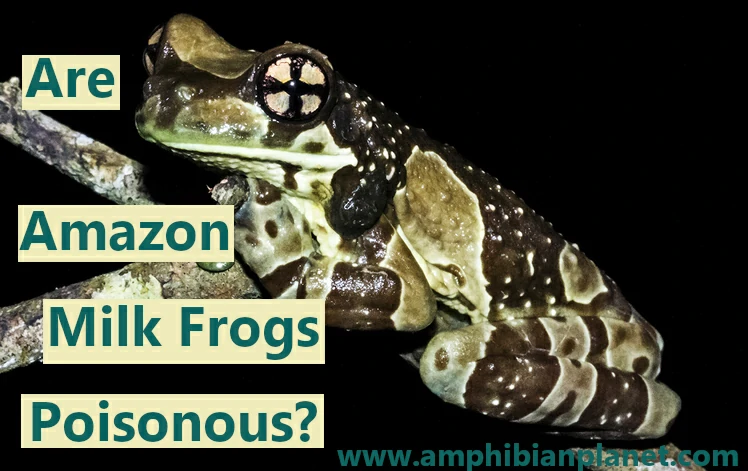Amazon milk frogs (Trachycephalus resinifictrix), sometimes called mission golden-eyed tree frogs – are fairly large tree frogs native to the Amazon Rainforest in South America. These frogs are a popular pet due to their unique appearance, and docile nature. But are Amazon milk frogs poisonous?
Amazon milk frogs are mildly poisonous. When stressed, they produce a milky toxic skin secretion that makes them taste bad to many would-be predators. This secretion is merely irritating and won’t kill a human, even if ingested. However, it can make some small animals sick.
Despite their toxin, Amazon milk frogs are unlikely to ever cause you any problems provided they are handled with care.
Their toxin is only harmful when ingested (such as when you pick up an Amazon milk frog with your bare hands, then rub your eyes or stick your fingers in your nose or mouth before washing your hands).
To be safe, always wash your hands after handling any Amazon milk frogs. Before washing your hands, do not touch your face, especially note your eyes, nose, or mouth.
Amazon Milk Frogs Are Only Mildly Poisonous
This milky fluid is where the “milk” in the common name “Amazon milk frog” comes from. Apart from deterring predators, the secretion also helps keeps these frogs hydrated.
Amazon Milk Frogs Are Not Venomous
It is important to note that there is a difference between a poisonous animal and a venomous one.
Sure, they both possess toxins that can be potentially harmful to us, but the difference lies in how those toxins are delivered.
Generally;
- Venomous animals will actively inject their toxins, usually via bites or stings.
- Poisonous animals on the other hand deliver their toxins more passively, usually by secreting the toxin on their skin, which is then absorbed by people (or animals) who have contact with it.
Poison can be ingested when it comes into contact with your eyes, lips, the mucus lining of the nose, or open cuts on your skin (think poison dart frogs).

Amazon milk frogs secrete a toxin on their skin to stop predators from eating them but cannot actively inject these toxins into a predator. This means they are poisonous, but not venomous.
Poisonous animals are typically not aggressive. They only use their toxins to defend themselves when another animal touches or tries to eat them.
Are Amazon Milk Frogs Dangerous to Humans?
Although poisonous, Amazon milk frogs typically aren’t dangerous to humans. The toxin they secrete isn’t potent enough to be of any serious harm to humans. Granted, it may cause some irritation or discomfort, but only if you ingest it.
This can happen when you handle an Amazon milk frog with your bare hands, then rub your eyes without first washing your hands.
Ingesting toxins this way would most likely give you a painful sting, and lead to severe irritation. It may even cause inflammation in the mucous membranes of your eyes.
Another way the toxins can be absorbed is through open sores or cuts on your skin. This would most likely lead to a burning sensation and a feeling of numbness at the point of contact.
The toxin can also be ingested through your mouth. Since most people won’t lick a frog or put it in their mouth, the most likely way you ingest toxins this way would be by touching an Amazon milk frog and then putting your fingers in your mouth before first washing your hands.
Another way the toxic secretion of the Amazon milk frog can be ingested is through the mucus membranes of your nose. For example, you touch an Amazon milk frog, then pick your nose before washing your hands.
For this reason, it is a good idea to avoid handling Amazon milk frogs. Although their poison is not lethal when ingested by humans, it can still be severely irritating, particularly when it comes in contact with your eyes.
If you ever need to handle an Amazon milk frog, remember to avoid touching your eyes, nose, or mouth until you have washed your hands.
It’s Not Just the Toxin to Be Worried About
Most, if not all amphibians can carry parasites and bacteria such as salmonella that can make people sick. One important bacteria is salmonella. Frogs can carry salmonella bacteria in their intestines and excrete them in their waste.

A frog carrying salmonella may look very clean and healthy but can pass the bacteria on to humans.
You can be exposed to salmonella by direct or indirect contact with a frog, it is waste or anything the frog came in contact with. (For example, if you touch an Amazon milk frog, its droppings or water where the frog has been, then touch stick your fingers into your mouth without first washing your hands).
Exposure to salmonella can cause an infection called salmonellosis in humans which is characterized by diarrhea, abdominal cramps, fever, and sometimes vomiting.
Fortunately, you will not catch a salmonella infection from simply touching or holding an Amazon milk frog. The bacteria can only cause illness when they are ingested.
Therefore, thoroughly washing your hands immediately after touching an Amazon milk should keep you out of harm’s way.
Are Amazon Milk Frogs Dangerous to Dogs, Cats, or Cats?
Since Amazon milk frogs secrete a toxin when threatened; a dog, cat, or any other animal that attacks one will get a mouthful of foul-tasting toxin and most likely let go right away.
If a dog or cat ingests enough of this toxin, it may salivate excessively, foam in the mouth, or possibly even vomit. The toxin may not be fatal, but it can make some dogs, or cats sick.
Fortunately, there are no documented deaths or serious injuries of pets that have attacked or tried to eat an Amazon milk frog.
Still, it’s best to keep your dogs, cats, or any other pets away from these frogs (or any other frogs), if you can.
Although only mildly poisonous, their secretion is still strong enough seriously irritate a dog (especially small dogs) or cat.
Safety Precautions to Take When Handling Amazon Milk Frogs
Generally, it is not a good idea to handle amphibians. This is because they have highly permeable skin that they use to breathe and also absorb moisture from their environments.
Their skin does not just absorb oxygen and moisture though, anything that comes in contact with the skin can be absorbed; including oils, salts, perfumes, lotions, soap, insect repellents, and other substances on your hands.
Handling an Amazon milk frog with unclean hands can harm and even potentially kill the frog if any harmful substances you may have on your hands make their way into its body.
For this reason, it’s advisable to observe all frogs from a distance without physically touching them.
If you ever need to handle an Amazon milk frog, take the following precautions to protect both you and the animal.
Before Handling
- Wash your hands EXTREMELY well so you don’t harm the salamander with any substances on your hands. Make sure to completely wash off any residue of soap so it does not remain on your skin.
- After washing your hands, dry them (preferably with paper towels), then re-moisten with dechlorinated water.
When Handling
- Keep the frog away from your eyes, nose, and mouth, and, be very careful not to rub your eyes, or touch your nose, or mouth.
- As you handle the frog, do it very gently and with care so you do not injure or stress the frog in any way. Amazon milk frogs (and other poisonous amphibians) only secrete their toxin to defend themselves when they feel threatened. Therefore, stressing one of these frogs will make it secret it is toxin all over your hands.
What to Do After Handling
- Very thoroughly wash your hands with anti-bacterial soap under running water.
Even if you were wearing gloves, it is still a good idea to go the extra mile by washing your hands. As earlier mentioned, Amazon milk frogs secrete a toxin and may carry bacteria that can be harmful, so it’s best to protect yourself.
Before washing your hands, do not touch anything (you could spread bacteria) – and remember not to rub your eyes, touch your face, or put anything into your mouth.
Featured image credit: Ediego Batista (CC BY-NC 4.0)
Commonly Asked Questions:
Are gray tree frogs poisonous to touch? Amazon milk frogs are indeed poisonous to touch. Remember, they secrete toxins all over their skin, and you can ingest these toxins if you do not wash your hands after touching an Amazon milk frog.
Are Amazon milk frogs poisonous to humans? The toxic secretion Amazon milk frogs produce is not potent enough to of any real threat to humans. However, it can be severely irritating when it comes in contact with your eyes and mucous membranes.
Sources:
Milwaukee Zoo: https://milwaukeezoo.org/about-us/our-blog/new-amazon-milk-frogs/
Smithsonian’s National Zoo and Conservation Biology Institute: https://nationalzoo.si.edu/animals/news/fun-facts-about-amazon-milk-frogs
Sacramento Zoo: https://www.saczoo.org/2022/03/fun-facts-amazon-milk-frogs/


